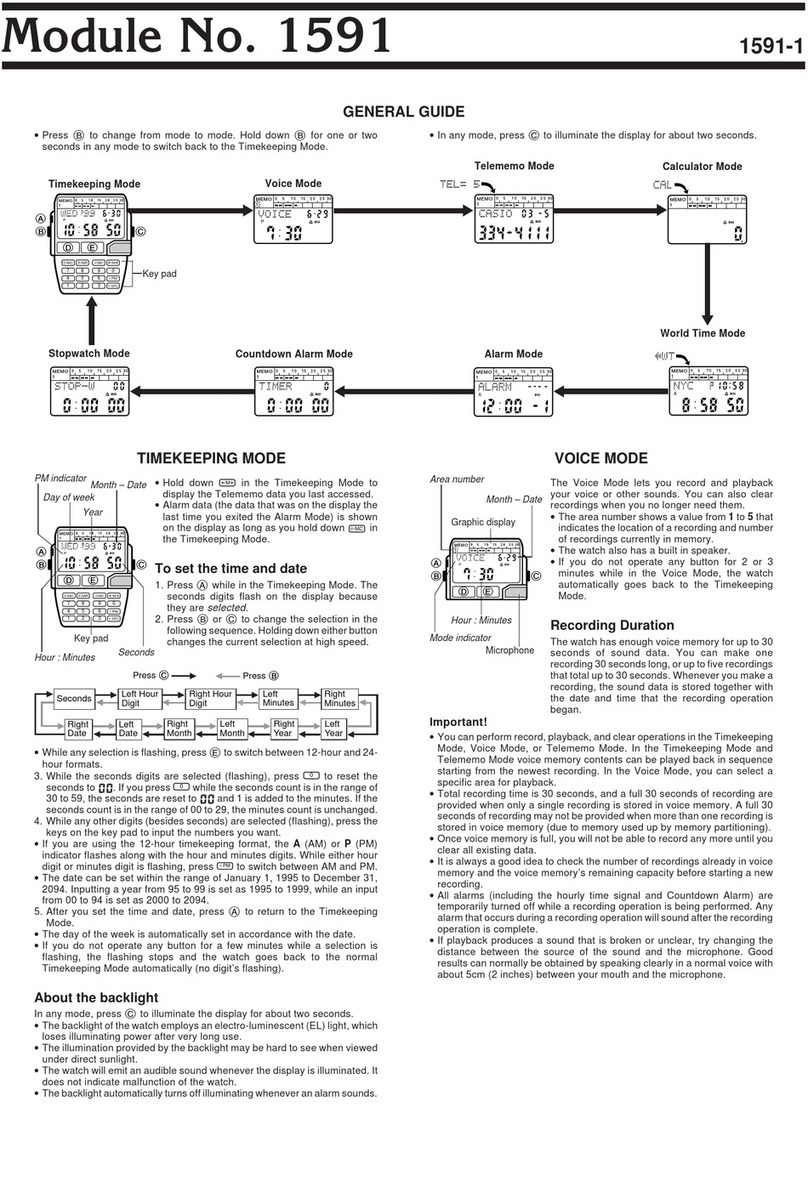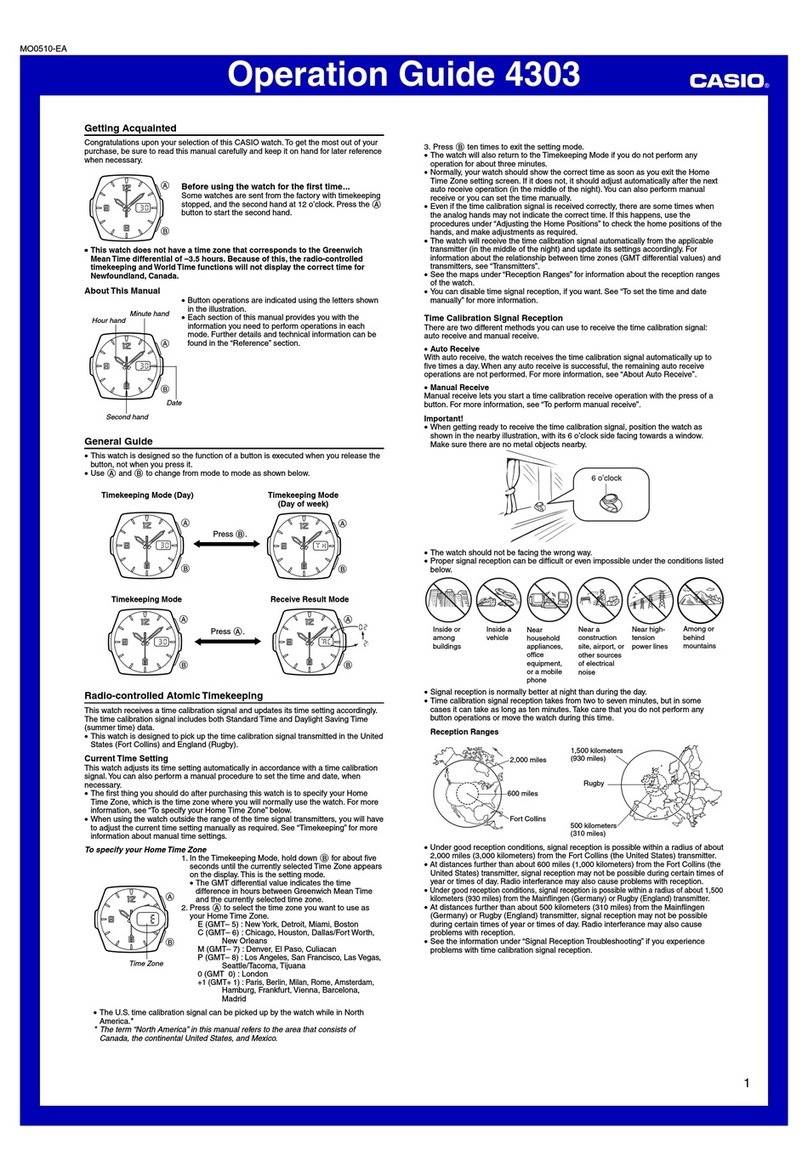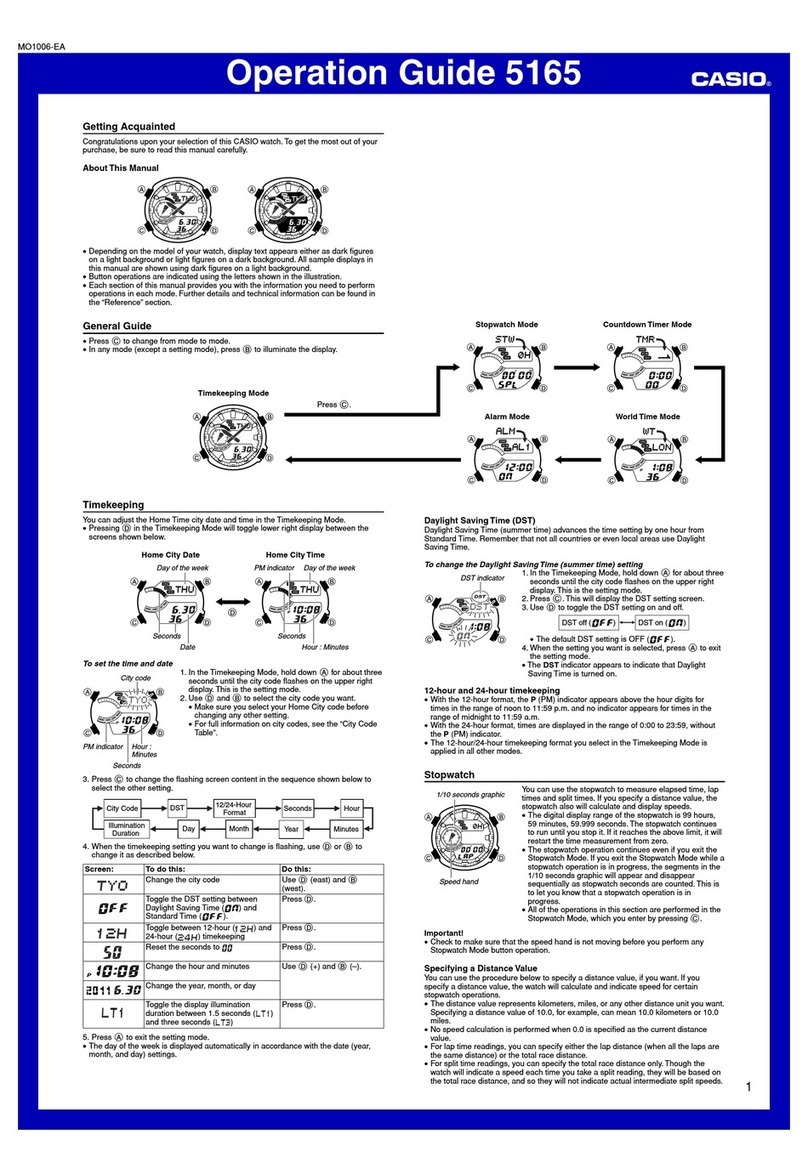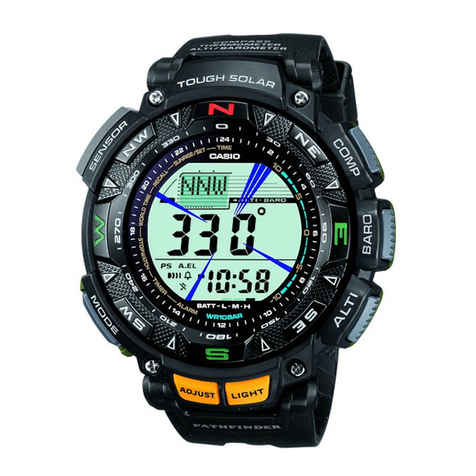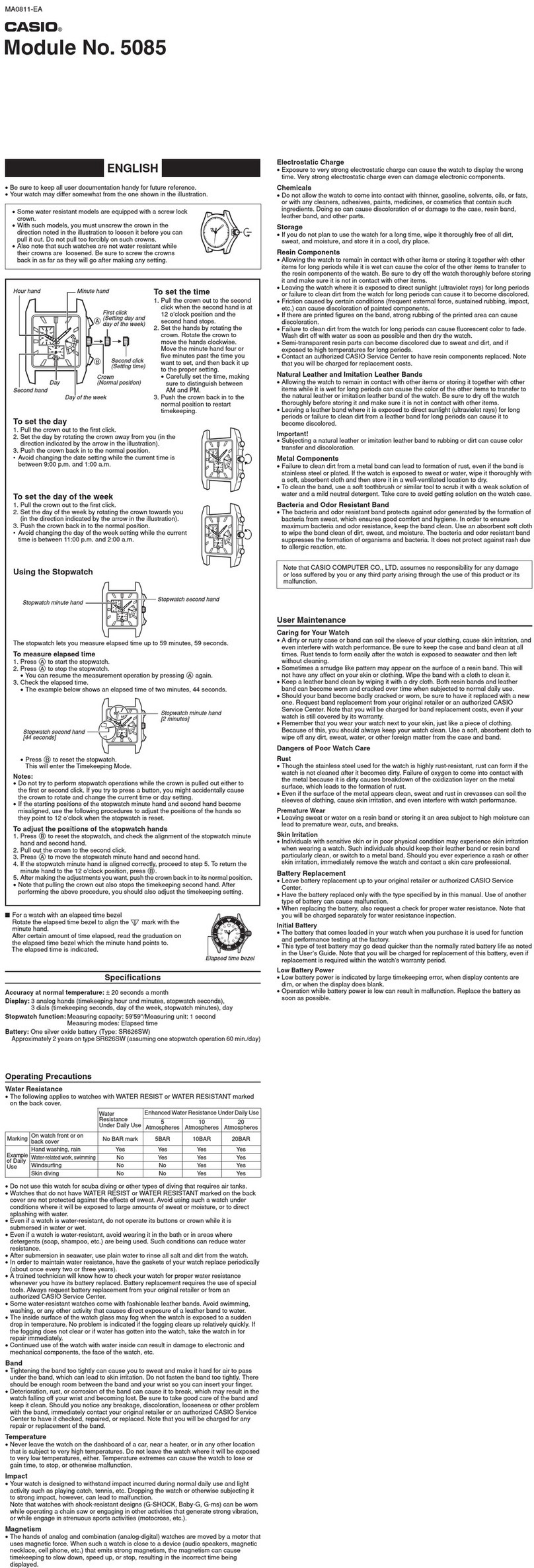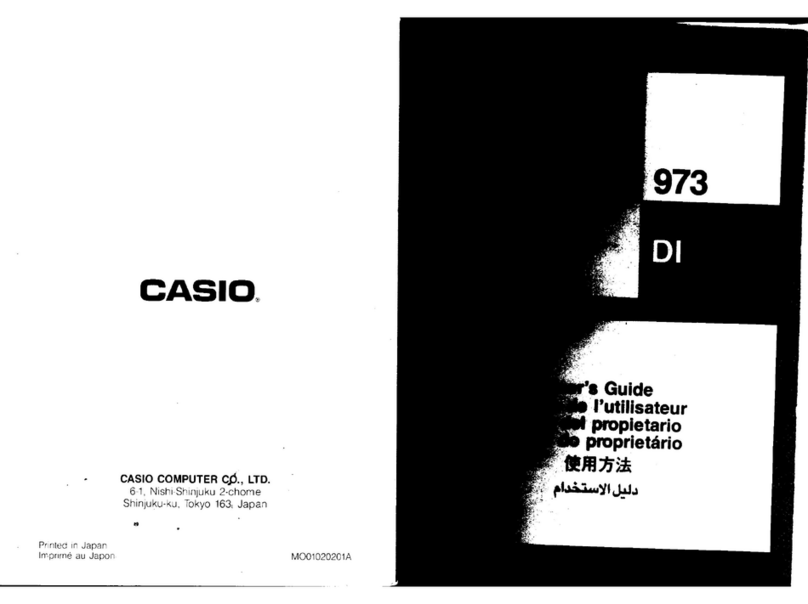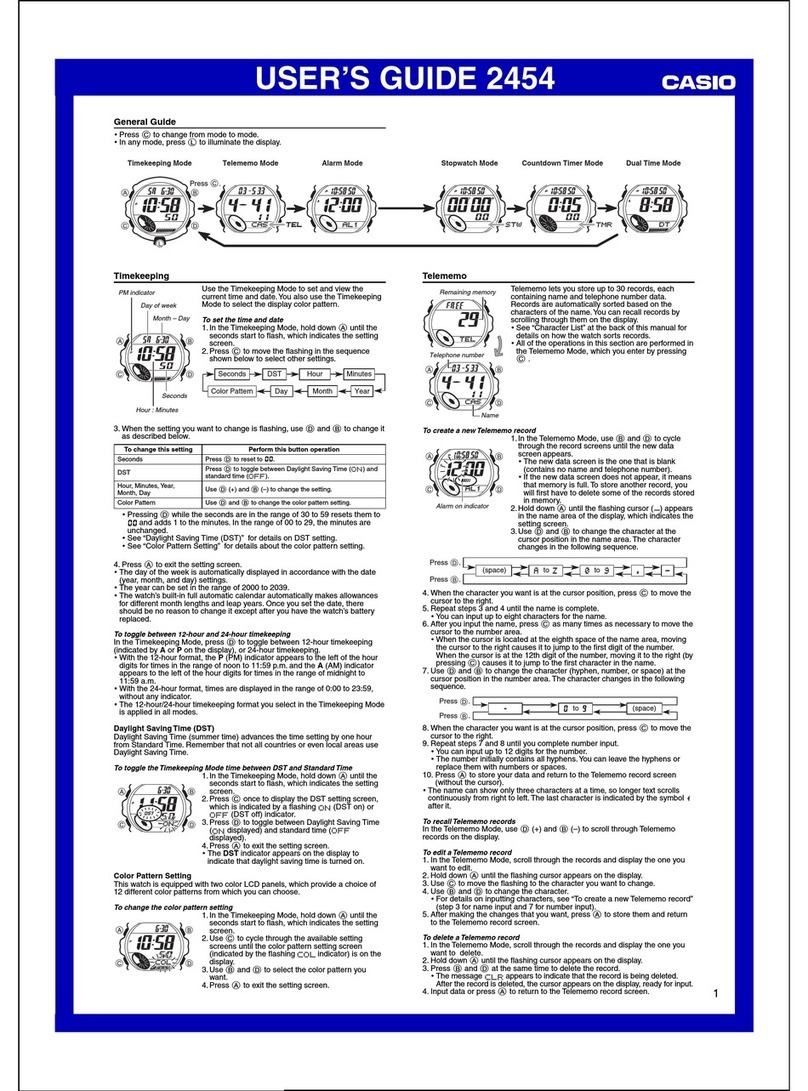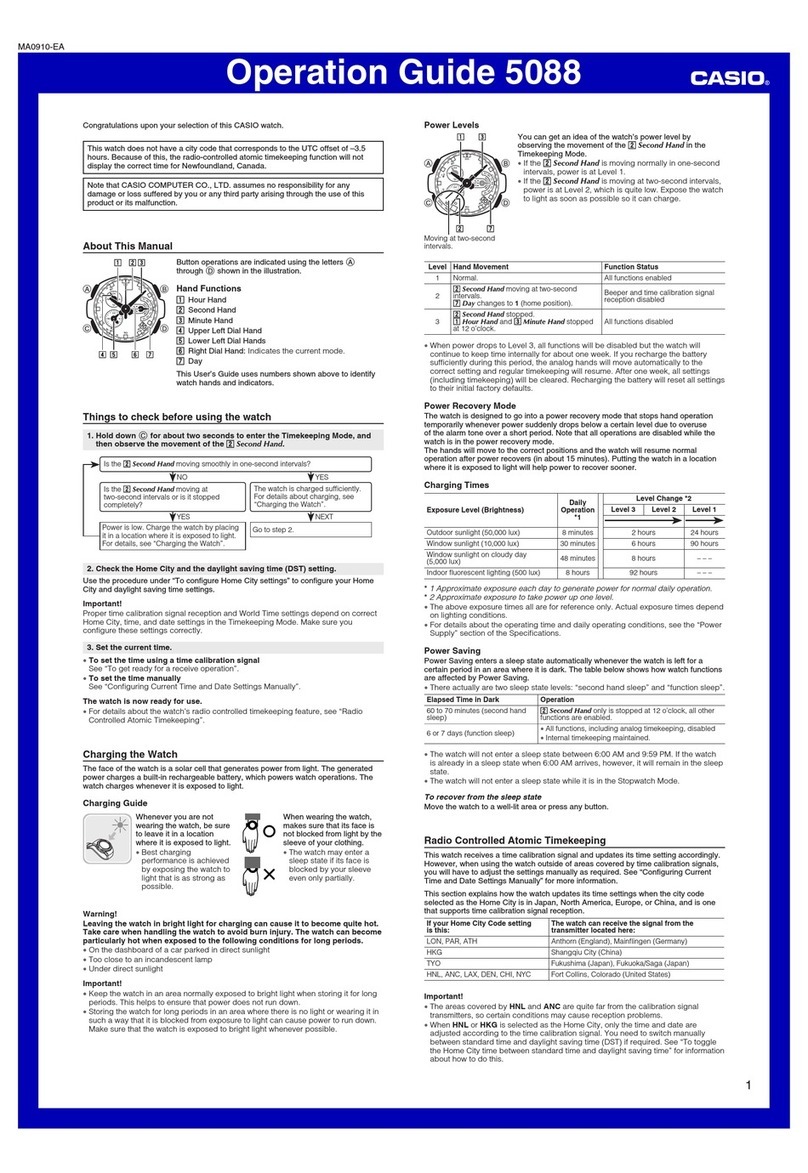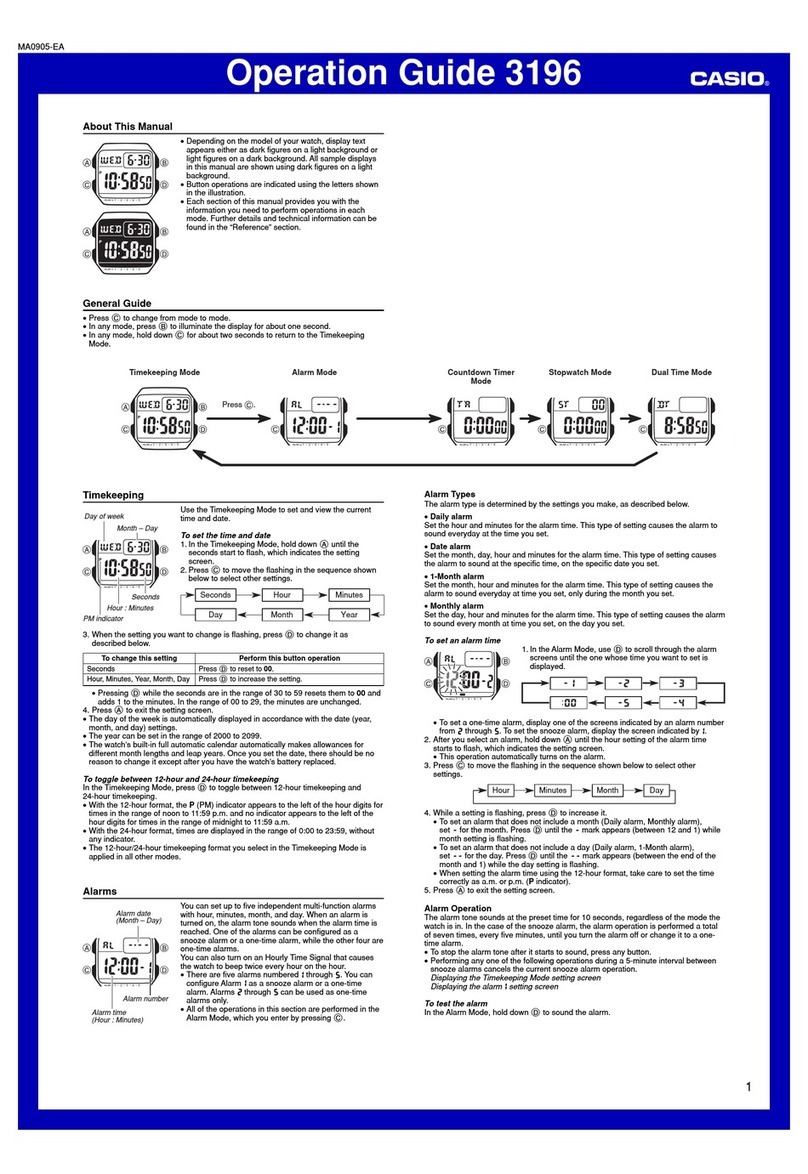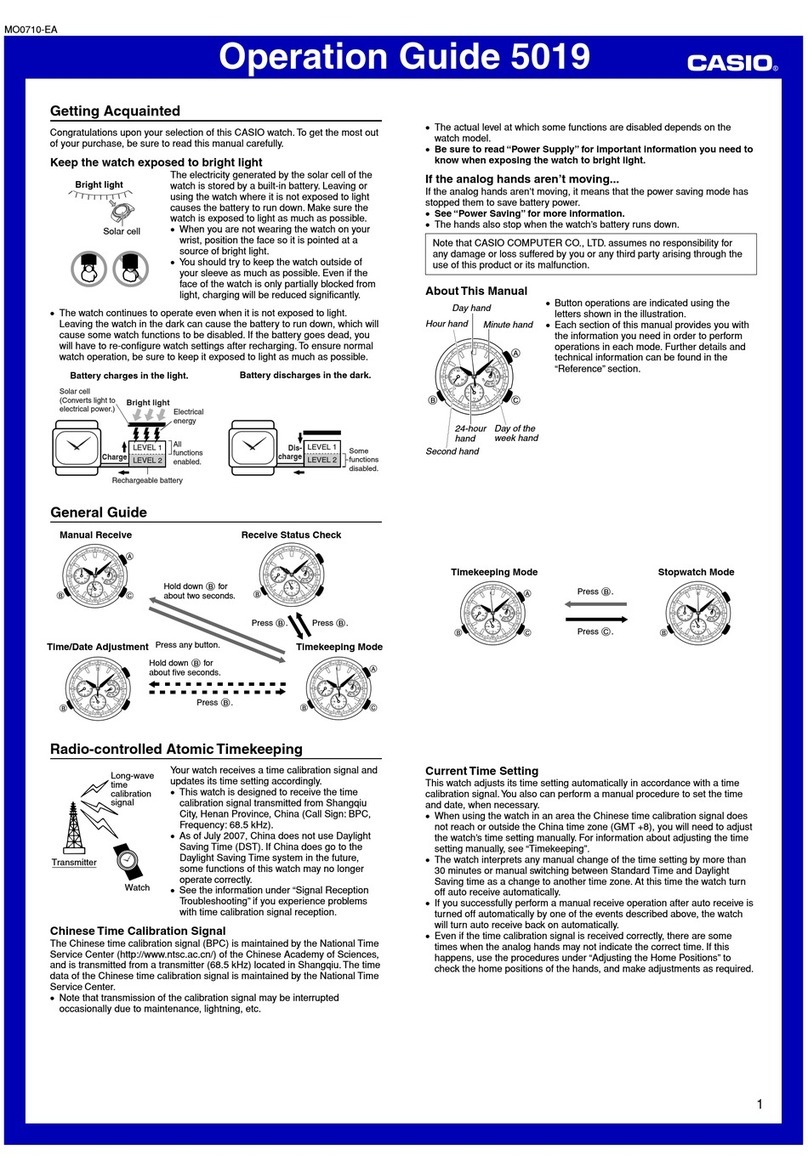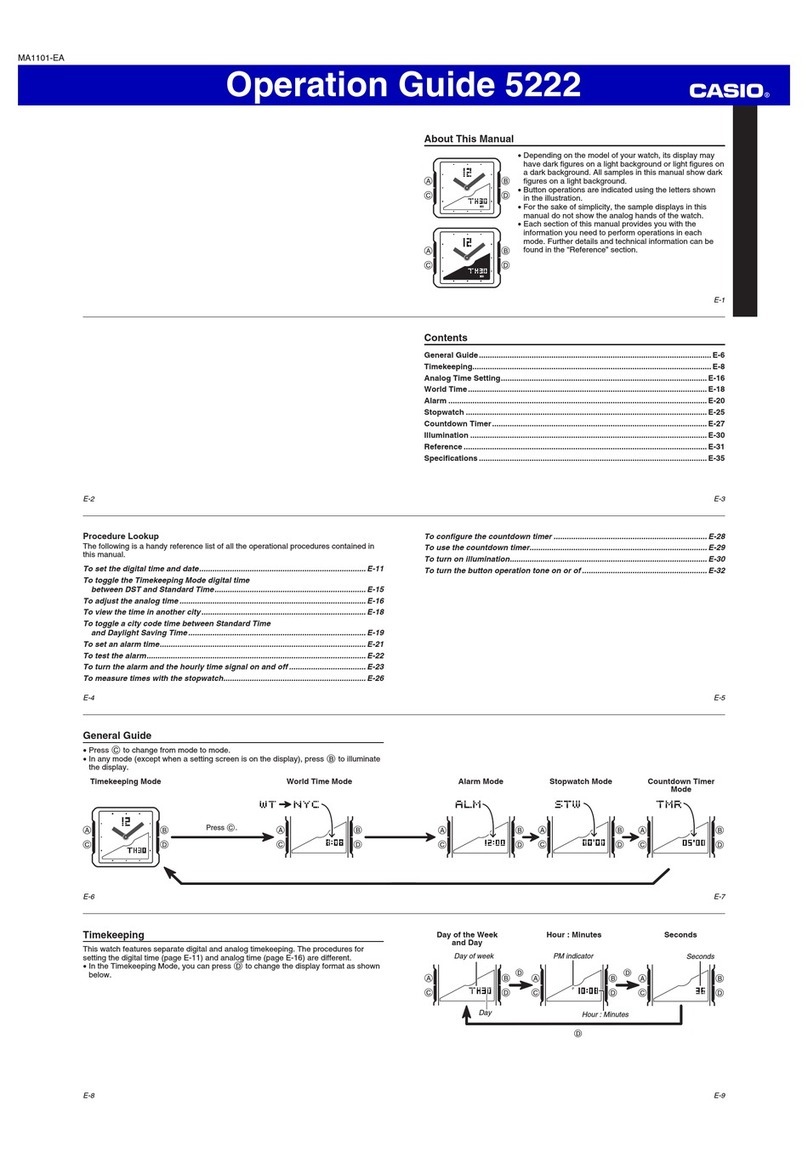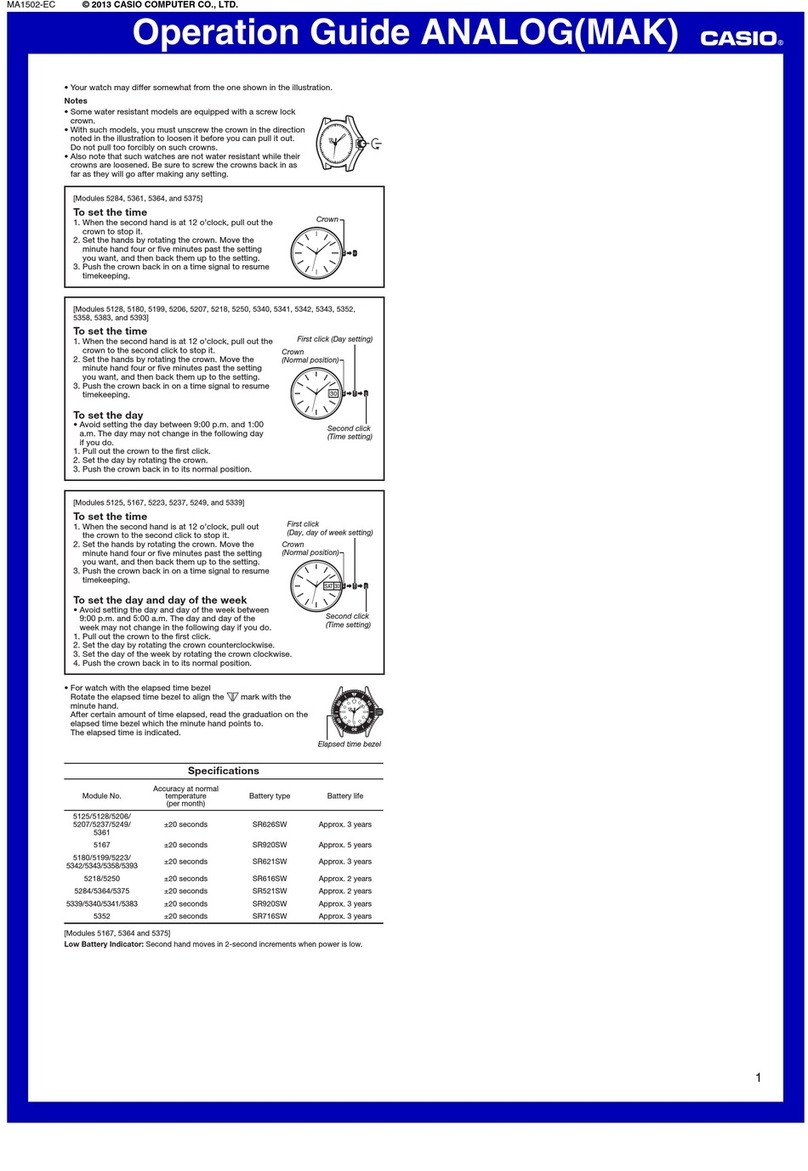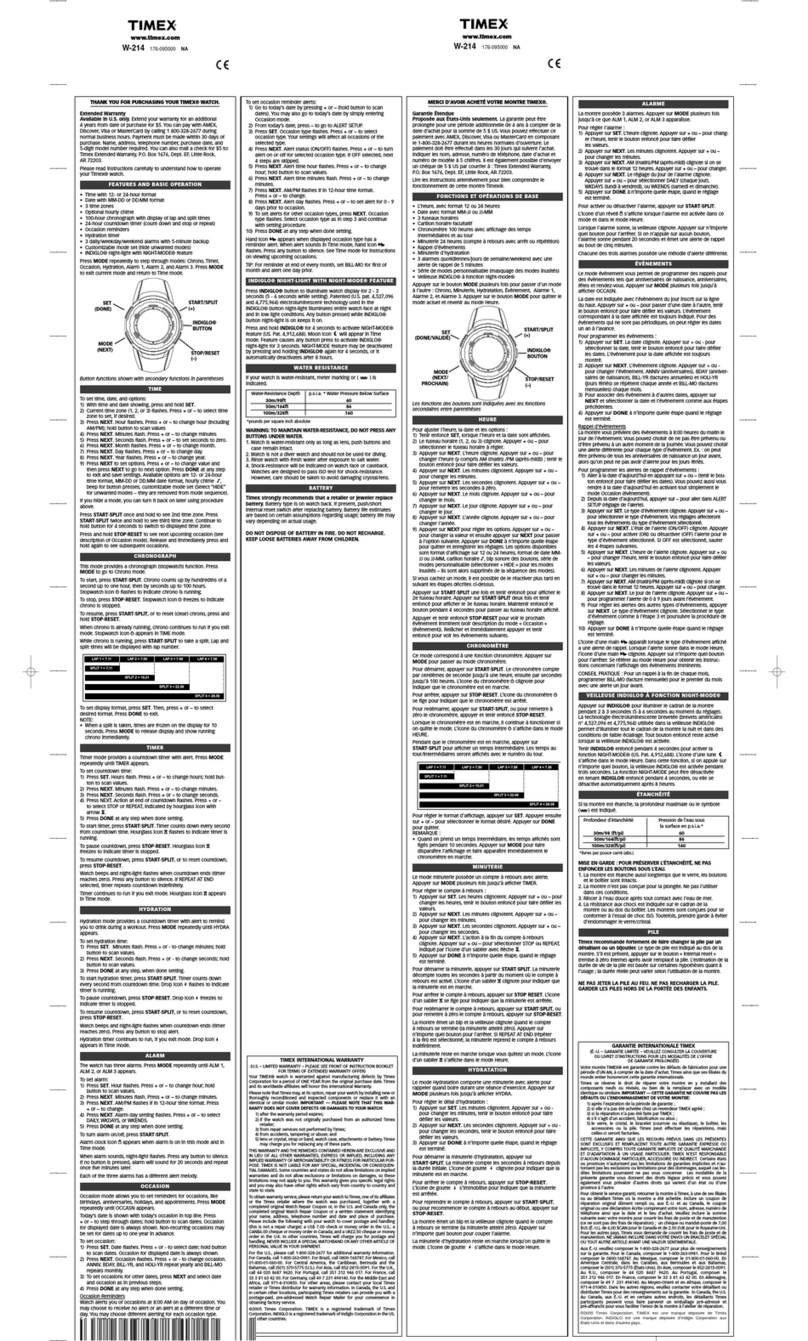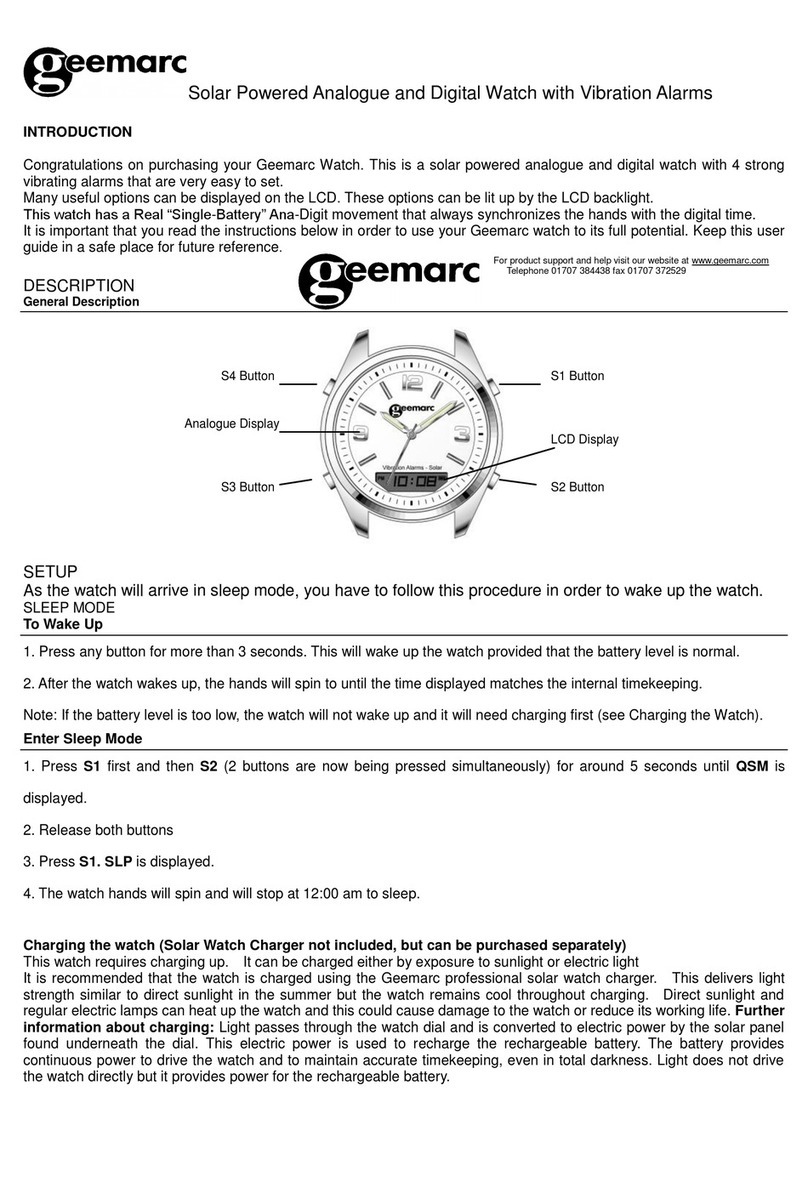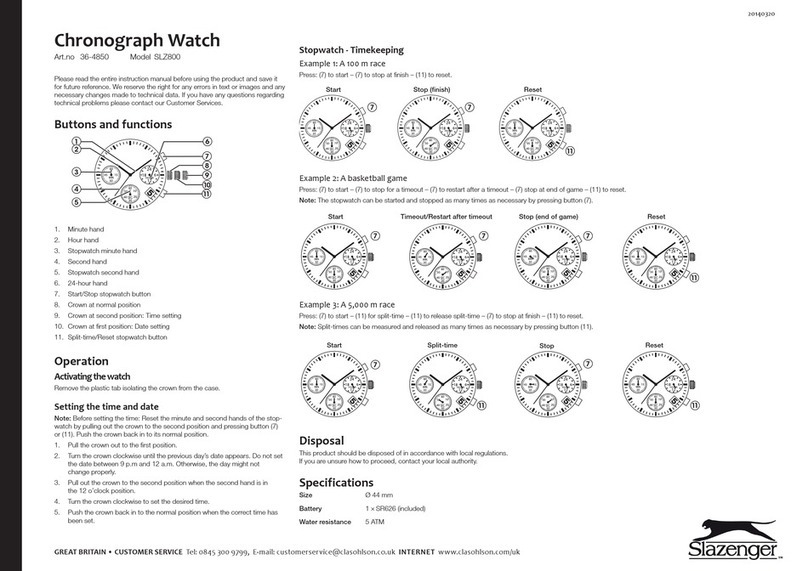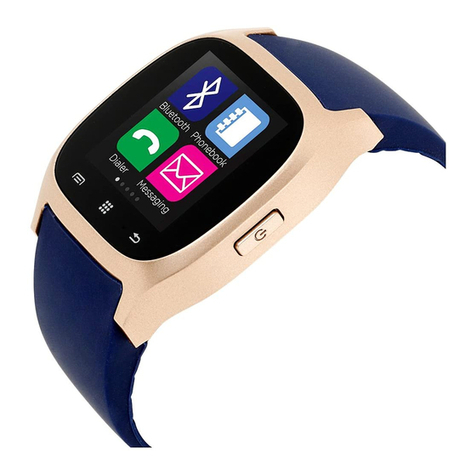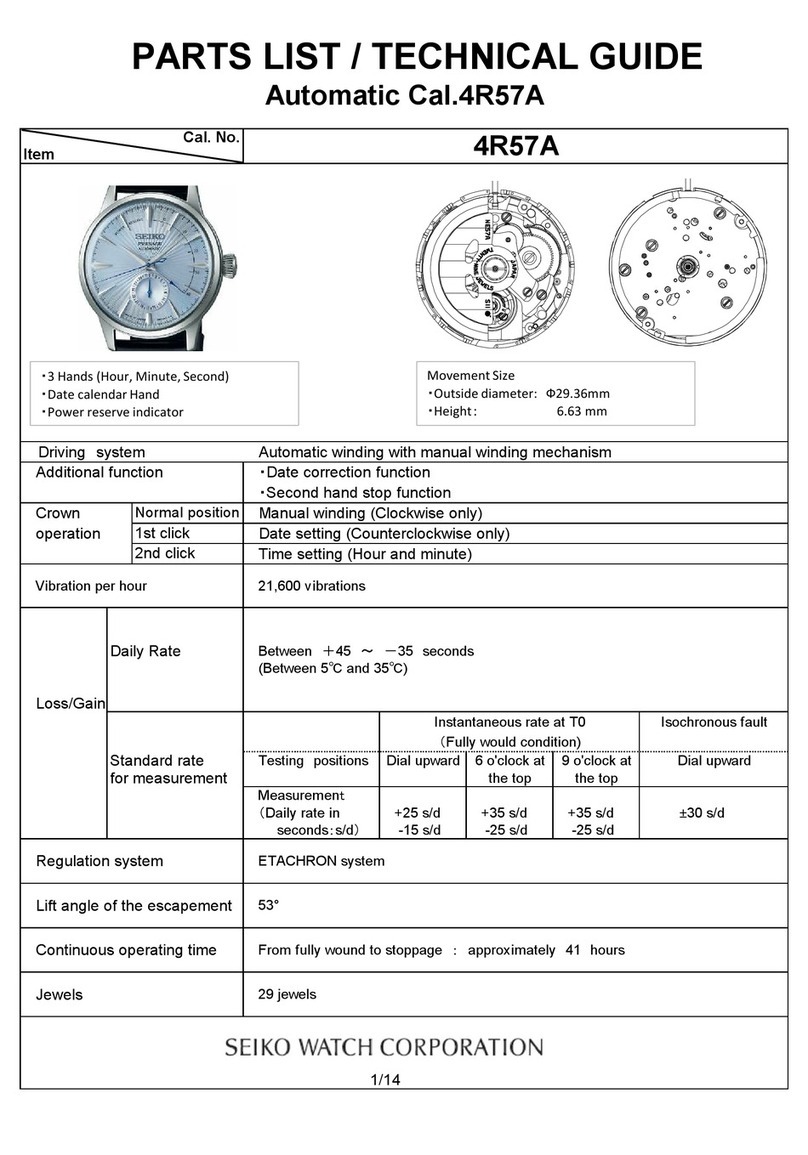
Operation Guide 2555 2868
2
Note
•The auto receive operation is performed only if the watch is in the Timekeeping
Mode or World Time Mode when one of the calibration times is reached. It is not
performed if a calibration time is reached while an alarm is sounding, or while you
are configuring settings (while settings are flashing on the display).
•Auto receipt of the calibration signal is designed to be performed early in the
morning, while you sleep (provided that the Timekeeping Mode time is set correctly).
Before going to bed for the night, remove the watch from your wrist, and put it in a
location where it can easily receive the signal.
•When auto receive is turned on, the watch receives the calibration signal for two to
five minutes everyday when the time in the Timekeeping Mode reaches each of the
calibration times. Do not perform any button operation within five minutes before or
after any one of the calibration times. Doing so can interfere with correct calibration.
•Remember that reception of the calibration signal depends on the time kept in the
digital display. The receive operation will be performed whenever the display shows
any one of the calibration times, regardless of whether or not the displayed time is
actually the correct time.
•When two, three, four, or five receptions are successful, the watch uses the data of
the last reception for calibration. When only one reception is successful, the watch
uses the data of the successful reception.
About the Receiving Indicator
The receiving indicator shows the strength of the calibration signal being received. For
best reception, be sure to keep the watch in a location where signal strength is
strongest.
Receiving indicator
•Even in an area where signal strength is strong, it takes about 10 seconds for signal
reception to stabilize enough for the receiving indicator to indicate signal strength.
•Use the receiving indicator as a guide for checking signal strength and for finding the
best location for the watch during signal receive operations.
•The Level 4 receiving indicator remains on the display in all modes following
reception of the time calibration signal and calibration of the watch’s time setting.
The Level 4 receiving indicator is not displayed if signal reception was unsuccessful
or after manual adjustment of the current time setting.
Weak Strong
(Level 1) (Level 4)
•The Level 4 receiving indicator is displayed only when the watch is able to
successfully receive both time and date data. It does not appear when only time data
is received.
•The Level 4 receiving indicator indicates that at least one of the calibration signal
receive operations was successful. Note, however, that the Level 4 receiving
indicator is cleared from the display at 3:00 a.m. each day.
To perform manual receive
1. Place the watch on a stable surface so its top (12
o’clock side) is facing towards a window.
•Note that signal reception is poor when the 12 o’clock
side of the watch is not facing towards a window.
2. In the Timekeeping Mode, hold down Dfor about two
seconds until the watch beeps.
3. Release Dand the message RC! appears to indicate
that signal reception has started.
•Time calibration signal reception takes from two to five
minutes. Take care that you do not perform any button
operations or move the watch during this time.
Receiving indicator
•After signal reception is complete, the display of the watch changes to the Last
Signal screen.
Note
•To interrupt a receive operation and return to the Timekeeping Mode, press D.
•If the receive operation is unsuccessful, the message ERR appears on the display
for about one or two minutes. After that, the watch returns to the Timekeeping Mode.
•You can also change from the Last Signal or ERR screen to the normal
timekeeping screen by pressing D.
To turn auto receive on and off
1. In the Timekeeping Mode, hold down Auntil the
transmitter indicator starts to flash, which indicates the
setting screen.
2. Press Cthree times to move the flashing to the auto
receive on/off setting.
3. Press Dto toggle auto receive on (ON) and off (OF).
•If the current Home City setting is a city code that
does not support signal receive, “xx”appears in
place of the on/off indicator. This means you cannot
turn auto receive on or off.
4. Press Ato exit the setting screen.
|
|
|
|
|
|
|
|
|
|
|
|
|
|
|
On/off status
•For further information, see “Important!”under “Time Calibration Signal Reception”
and “Radio-controlled Timekeeping Precautions”.
Signal Receive Troubleshooting
Check the following points whenever you experience problems with calibration signal
reception.
Problem
Cannot perform
manual receive.
Auto receive is
turned on, but
the Level 4
receiving
indicator does
not appear on
the display.
Time setting is
incorrect
following signal
reception.
Probable Cause
•
The watch is not in the Timekeeping Mode.
•Your current Home City is not one of the
following city codes:
BER, PAR, or LON.
•The transmitter setting is incorrect.
•The transmitter setting is incorrect.
•You changed the time setting manually.
•The watch was not in the Timekeeping
or World Time Mode, or you performed
some button operation during the auto
receive operation.
•
Even if receive is successful, the Level 4
receiving indicator disappears every day
at 3 am.
•Time data (hour, minutes, seconds) only
was received during the last receive
operation. The Level 4 receiving
indicator appears only when time data
and date data (year, month, day) are
both received.
•If the time is one hour off, the DST
setting may be incorrect.
•The Home City code setting is not
correct for the area where you are using
the watch.
What you should do
•Enter the Timekeeping Mode
and try again.
•Select BER, PAR, or LON
as your Home City.
•Select the transmitter setting
appropriate for your current
location.
•Select the transmitter setting
appropriate for your current
location.
•Perform manual signal receive
or wait until the next auto
signal receive operation is
performed.
•Check to make sure the watch
is in a location where it can
receive the signal.
•Change the DST setting to
Auto DST.
•Select the correct Home City
code.
World Time
The World Time shows the current time in 30 cities (29
time zones) around the world.
•If the current time shown for a city is wrong, check your
Timekeeping Mode time and Home City settings and
make the necessary changes.
•The watch will perform a signal receive operation even if
it is in the World Time Mode when a calibration time is
reached. If this happens, the World Time Mode time
settings will be adjusted in accordance with the
Timekeeping Mode’s Home City time.
•All of the operations in this section are performed in the
World Time Mode, which you enter by pressing C.
Current time in the
selected city code
(Hour : Minutes Seconds)
City code
Home city time
DST indicator
To view the time in another city code
In the World Time Mode, press Dto scroll through city codes (time zones) to the east
or Ato scroll to the west.
•For full information on city codes, see the “City Code Table”.
•The World Time Mode times are always displayed using 24-hour format.
•You can change the DST (Daylight Saving Time)/Standard Time settings for each
city code in the Timekeeping Mode. See “Daylight Saving Time (DST)”for more
information.
Alarms
The Alarm Mode gives you a choice of four one-time
alarms and one snooze alarm. One of the one-time
alarms functions as a “target alarm”, which counts the
time remaining from the current Timekeeping Mode time
(Home City time) to the target alarm time.
Also use the Alarm Mode to turn the Hourly Time Signal
(SIG) on and off.
•There are five alarms numbered AL1 through AL3,
TAL,and SNZ. You can configure SNZ as a
snooze alarm only. Alarms AL1 through TAL
(target alarm) can be used as one-time alarms only.
•Alarm settings (and Hourly Time Signal settings) are
available in the Alarm Mode, which you enter by
pressing C.
Alarm time (Hour : Minutes)
Home city time
Alarm number
Countdown
(Hours : Minutes Seconds)
Target Alarm Screen
To set an alarm time
1. In the Alarm Mode, use Dto scroll through the alarm
screens until the one whose time you want to set is
displayed.
2. After you select an alarm, hold down Auntil the hour
setting of the alarm time starts to flash, which indicates
the setting screen.
•This operation automatically turns on the alarm.
3. Use Cto move the flashing in the sequence shown
below to select other settings.
MinutesHour On/Off
AL1 AL2 AL3
SIG SNZ TAL
Alarm on indicator
Snooze indicator
4. While a setting is flashing, use Dand Bto change it.
•While the hour or minute setting is flashing, use D(+) and B(–) to change it.
•While the on/off setting is flashing, use Dto toggle it on (ON) and off (OF).
5. Press Ato exit the setting screen.
•When setting the alarm time using the 12-hour format, take care to set the time
correctly as a.m. (no indicator) or p.m. (Pindicator).
Alarm Operation
The alarm tone sounds at the preset time for 10 seconds, regardless of the mode the
watch is in. In the case of the snooze alarm, the alarm operation is performed a total
of seven times, every five minutes, or until you turn the alarm off.
•Pressing any button stops the alarm tone operation.
•If any alarm operation (one-time alarm, snooze) occurs while a signal receive
operation is in progress, the receive operation is canceled.
•Displaying the Timekeeping Mode setting screen during a 5-minute interval between
snooze alarms stops the current snooze alarm operation (but snooze alarm remains
as the alarm type setting).
•The snooze indicator ( ) flashes during the 5-minute intervals between alarms.
•The alarm on indicator ( ) and snooze indicator ( ) are displayed in all modes.
•In all modes, the alarm on indicator is shown for any alarm that is currently turned
on.
To test the alarm
In the Alarm Mode, hold down Dto sound the alarm.
